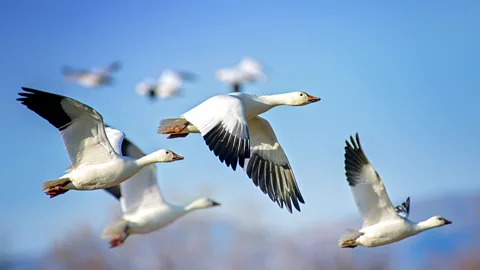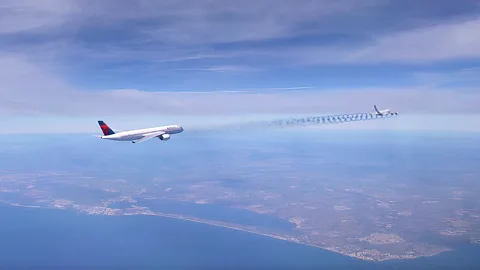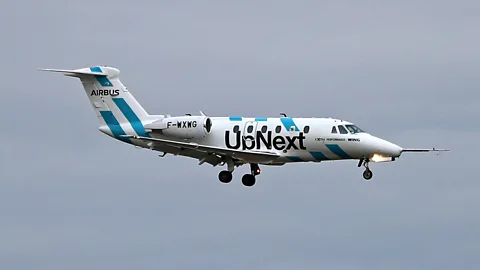The aircraft that may fly like a flock of geese
 Getty Images
Getty ImagesSome species of birds like geese save energy by flying in close formation. Airliners could use a similar trick to burn less fuel.
In the early 1500s, Italian Renaissance master Leonardo da Vinci developed a fascination with avian flight. He spent his days meticulously studying the movement of birds, sketching observations of how they maintain their balance and perform soaring manoeuvres.
His ambition was to make a flying machine from his scientific investigations. But what he wound up creating instead was the seminal work Codex on the Flight of Birds. It pioneered what would later become the field of "biomimicry", the study of the natural world in search of efficient design.
Centuries later, experimentation flourished. Pioneering aviators like Otto Lilienthal, Igo Etrich and the Wright brothers mimicked birds to design their aircraft and the aviation industry was born.
In 2019, Airbus returned to the study of birds with the "fello'fly" project to understand how migrating geese conserve energy while flying in V formation. From it, a "wake energy retrieval" technique was developed to help trailing jets pinpoint the optimal location to fly in the wake vortex of a lead jet. This was found to generate fuel savings of 5% to 10% per trip, similar to findings published by the US space agency Nasa.
In July 2023, the effort evolved into the Geese project with €10m (£8.4m/$10.5m) in funding, and support from the European Union's air traffic management research arm, Sesar.
 Delta
DeltaEarlier this month, Delta Air Lines and Airbus announced that they were taking the "fello'fly" concept out of the lab and into the skies, targeting the second half of this year to deploy the technique into live operations. The goal will be to test a manoeuvre called "rendez-vous" in which two passenger jets are paired over the Atlantic Ocean. For example, this could be an Air France flight from New York City and a Delta Air Lines flight from Miami, both heading to London. In pairing, the two planes would be separated by the regulatory 1,000ft (303m) in altitude while attempting to reduce the distance between them to 1.2 nautical miles (2.2km), the same distance that fuel savings were most recently achieved in the lab.
Delta chief sustainability officer Amelia DeLuca tells the BBC that this distance is substantially closer than planes fly today, which is typically at a separation of three to five nautical miles (5.5 to 9.2km), so the first step will be to see whether the gap can be narrowed without compromising safety.
This video shows an animation of how "fello'fly" is expected to work.
As for why transatlantic flights were chosen for the test, DeLuca explains, "there are very few sustainable solutions for wide bodies flying today, besides sustainable aviation fuel. So a 5% benefit off of a flight that's going across the Atlantic with a big airplane that's burning a lot of fuel has the biggest bang for the buck".
Stephen Trent, an analyst at Citi, says on some routes the formation flying technique could be useuful. "My guess is that it is also somewhat route dependent, and somewhat dependent on what kind of equipment you're operating. So the opportunity to do that, for example, flying from New York to London, is not going to be the same as an aircraft that's flying from Miami to Mexico City. It's possible that, in some cases, that's something that could help – like a tailwind that pushes a sailing ship."
Aiming to decarbonise operations by 2050, the Delta Carbon Council reported that it had saved 41 million gallons (65,800 tonnes) of jet fuel in 2024. DeLuca says that to achieve this, Delta is constantly on the lookout for new ways to conserve energy, like plugging into ground power instead of operating engines on the ground, doing a shorter vector on approach instead of a long roundabout when landing, and installing winglets that point up on the tips of wings to reduce drag.
Other industry practices include continuous climb and decline operations that enable an altitude to be reached without the need for levelling and adjusting the centre of gravity on the aircraft to reduce drag. Switching to a renewable energy source like sustainable aircraft fuel is also seen as a solution, however this will require a staggering amount of land to grow enough biomass to make biofuels.
DeLuca says Delta quadrupled its sustainable aircraft fuel (SAF) usage in 2024, but that's still less than 1% of the fuel being used with it. The main hurdle, she says, is the supply of sustainable fuel. However, she's encouraged by Airbus joining Delta which has stated a commitment to purchase several million gallons of SAF annually starting in the second half of 2025.
 Getty Images
Getty ImagesKnowing customers are lining up to buy the product gives farmers in rural communities a reason to redirect soy and corn ethanol production into sustainable aviation fuel, says DeLuca.
"It's really about economic and social development in rural communities – job creation, attracting investment into these communities. It's a new industry, so will be a big development opportunity for these sites," Airbus chief sustainability officer Julie Kitcher tells the BBC.
Trent says sustainable aviation fuel won't yet be a silver bullet because it costs far more than conventional fuel. "Let's say today jet fuel kerosene is like $2.50 (£2) a gallon. If you look at SAF a gallon it can be more than three times that price... Assuming production needs to increase, then bring the price down."
More like this:
• Extreme flying in the name of science
Meanwhile, across the airline industry, interest in biomimicry has been growing.
Airbus has a project through its UpNext innovation lab taking inspiration from eagles, with the goal of creating longer, leaner and lighter high-performance, ultra-flexible wings that can bend and evolve depending on air current and turbulence, with hinges that adapt dynamically and sensors that can determine nuanced movements. It is similar to the morphing wing created by Nasa.
They are not the only company looking into the technique. Boeing has a partnership with Nasa where it is testing coatings to reduce insect adhesion through the study of lotus leaves.
And Lufthansa has been working with chemicals manufacturer BASF on developing a surface film called AeroShark to simulate the texture of shark skin in an effort to save millions of tonnes of fuel per year.
"Birds are the experts of flight and so we're using nature to inspire technology," Kitcher says. For formation flying, they may be the greatest teachers.
--
If you liked this story, sign up for The Essential List newsletter – a handpicked selection of features, videos and can't-miss news, delivered to your inbox twice a week.
For more science, technology, environment and health stories from the BBC, follow us on Facebook, X and Instagram.
